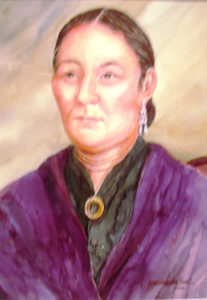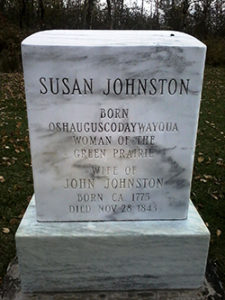 Ozhahguscodaywayquay, “Woman of the glade,” later known as “Neengay” (Mother) and still later as Susan, was the wife of John Johnston, a fur trader and leading citizen at Sault Ste. Marie. Through her family connections with prominent Indians of the Upper Great Lakes region, and her natural capabilities and talents, she came to play a vital role in the history of this area.
Ozhahguscodaywayquay, “Woman of the glade,” later known as “Neengay” (Mother) and still later as Susan, was the wife of John Johnston, a fur trader and leading citizen at Sault Ste. Marie. Through her family connections with prominent Indians of the Upper Great Lakes region, and her natural capabilities and talents, she came to play a vital role in the history of this area.
Born in about 1772 at La Pointe, she was raised in the Ojibway culture, learning traditional food gathering and preparation. She was taught quillwork and beadwork, and learned the legends and stories of her people. From her father, she inherited a poetical talent. Her grandfather was Ma-mongazida (“Big Foot” or “Loon’s Feet”), an Ojibway warrior chief who fought with the French under General Montcalm on the Plains of Abraham in 1769. Her father was Waubojeeg (“White Fisher”), also an Ojibway chieftain, but one who did not align with any of the white men. Instead, he fought against the Sioux, driving them from the Lake Superior region.
In 1791, John Johnston came to La Pointe, WI to begin his new career as a fur trader. He was later abandoned by his men and had the good fortune to be befriended by Ozhahguscodaywayquay’s father and grandfather. Meeting and falling in love with the Indian maiden, he asked to marry her. Waubojeeg refused, sending Johnston back to Montrèal with a promise that if he returned the following year and still wanted to marry her, he would be allowed to do so. Johnston returned the following summer, and the two were married according to Indian custom.
Ozhahguscodaywayquay prior to her marriage had made an “apowa”, fasting in isolation to find her guardian spirit that would tell her what to do. Notwithstanding that the spirit that appeared to her was a white man and her dream vision showed her helping her people and receiving great honor from them, she did not immediately accept Johnston. Within a few days of her marriage, she ran away from him, but was brought back in disgrace by her father and grandfather. From then on, she remained with Johnston and soon came to appreciate and love her new husband.
In 1793, after the birth of their first child, Lewis Saurin, the two moved to Sault Ste. Marie. They eventually had seven more children, all born at the Sault. As an independent fur trader, Johnston established ties through his wife’s relatives and connections. The family’s lifestyle, dress, and pastimes expressed the cultures of both parents. The children were fluent in French, English, and Ojibway. Ozhahguscodaywayquay – now Neengay – spoke only Ojibway, although she understood both French and English.
 The War of 1812 brought about a change in the family’s fortunes. Johnston joined the war on the side of the British. In 1814, while Johnston was en route to defend Mackinac Island from the Americans efforts to recapture it, an American force came up the St. Mary’s River and burned the Johnston’s storehouses and other outbuildings, believing them to be part of the Northwest Fur Company’s holding. In the following years, as the family worked to recover from their losses, Neengay helped through her influence with the Indians, who increasingly came to the Sault Ste. Marie area, drawn there by the Johnston family’s presence. Her expertise in traditional Indian domestic skills also made it possible for the family to maintain the level of comfort and plenty they had enjoyed prior to 1812.
The War of 1812 brought about a change in the family’s fortunes. Johnston joined the war on the side of the British. In 1814, while Johnston was en route to defend Mackinac Island from the Americans efforts to recapture it, an American force came up the St. Mary’s River and burned the Johnston’s storehouses and other outbuildings, believing them to be part of the Northwest Fur Company’s holding. In the following years, as the family worked to recover from their losses, Neengay helped through her influence with the Indians, who increasingly came to the Sault Ste. Marie area, drawn there by the Johnston family’s presence. Her expertise in traditional Indian domestic skills also made it possible for the family to maintain the level of comfort and plenty they had enjoyed prior to 1812.
In June of 1820, Governor Lewis Cass of the Michigan Territory came to the Sault with a contingent of U.S. troops in order to establish a U.S. presence in the area and to purchase land for a fort. John Johnston was in Ireland at the time, and Neengay, with her son George, welcomed the visitors. The Indians were not willing to accept the U.S. presence in the area. Neengay, through her influence with the elder chiefs, managed to avert an uprising of the Indians. A treaty was signed on June 16, 1820, ceding land at Sault Ste. Marie for the desired fort.
In 1821, the Johnston marriage was formalized in a civil ceremony at the Sault – fulfilling a promise Johnston had made to Ozhahguscodaywayquay’s father at the time of the couple’s Indian-style wedding 29 years earlier. By this time, Neengay had taken the name Susan, as shown on the marriage certificate. In 1823, Henry Rowe Schoolcraft, the newly appointed Indian Agent to the area, married Jane, one being Bamewawagezihkaquay (The Sound the Stars Make Rushing Through the Sky), the Johnston’s eldest daughter. Schoolcraft developed an interest in the Indian culture, languages, and lifestyle. His studies were greatly helped by Susan and her children. She related legends of her tribe and assisted Schoolcraft in his exploration of the Ojibway vocabulary. Schoolcraft’s published works were, years later, the basis of Henry Wadsworth Longfellow’s poem The Song of Hiawatha.
Following increasing illness, John Johnston died on September 22, 1828. Susan made a plaque for the coffin out of hammered silver teaspoons. After Johnston’s death, Susan, with the help of her son William, continued to run the family fur-trading business until 1831. Later, she provided for herself and other family members by engaging in fishing expeditions with local Indians and traveling to Sugar Island each spring to manufacture maple sugar on property she had chosen as her share of land obtained through the 1826 Treaty of Fond du Lac.
In 1832, Susan and her family joined the Presbyterian Church, organized that year by the Reverend Jeremiah Porter. Susan loaned an old store building, located close to the Johnston house, for services. In the fall of 1832, she had a small church, a simple wooden structure without a steeple, erected for the congregation.
The last few years of her life were quiet ones, she and her daughter Eliza lived alone in the family homestead. She died on November 28, 1843, and is buried next to her husband in Riverside Cemetery.
The John Johnston’s house is located adjacent to the U.S. Coast Guard Base – Sault Ste. Marie Sector. It is owned by the City of Sault Ste. Marie, along with the Schoolcraft Home, and Bishop Frederic Baraga “Palace”. The Historic Homes are opened to the general public seven days a week, from Memorial Day until Labor Day. Docents from the Chippewa County Historical Society invite the visitors to join them for a glimpse of the past. For more information on the River of History museum, the Water Street Historic Homes, and many other historic sites in our city, visit the River of History web site www.riverofhistory.org and Like them on Facebook.
